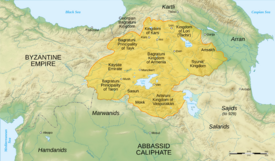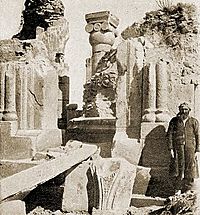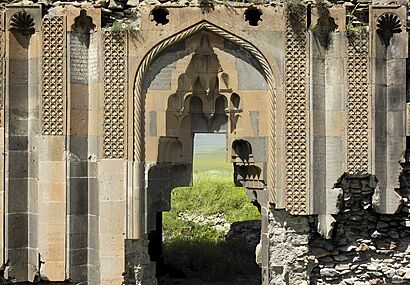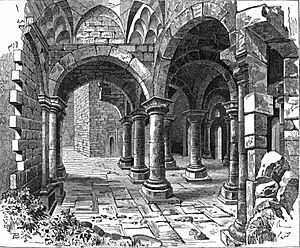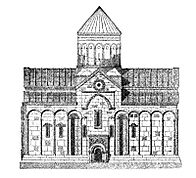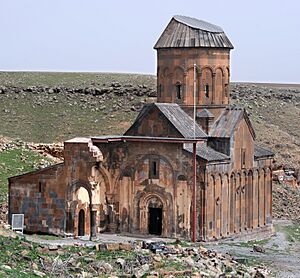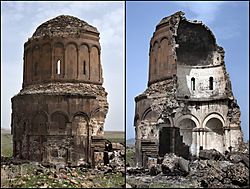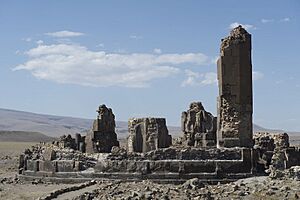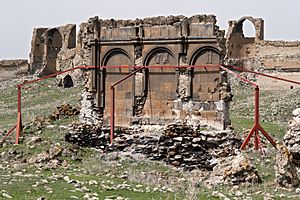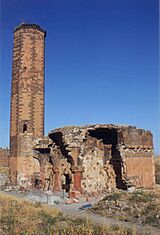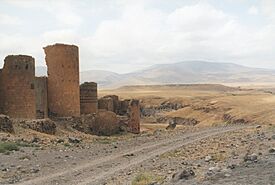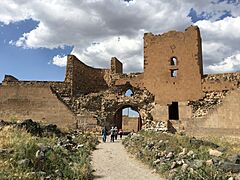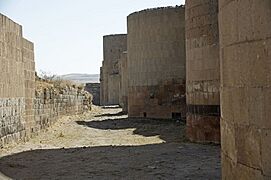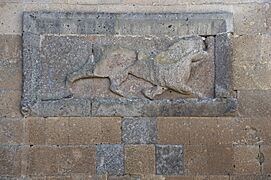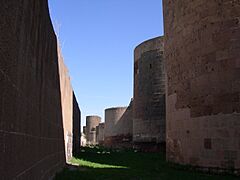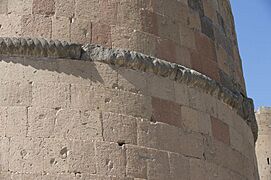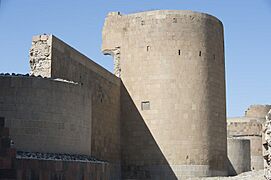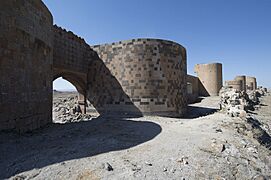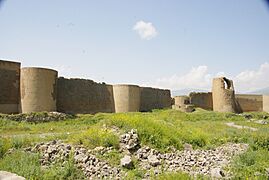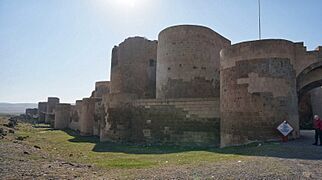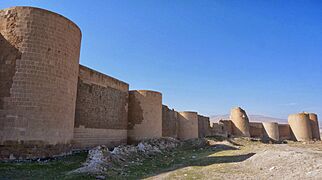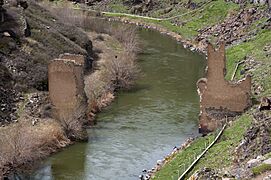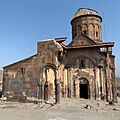Ani facts for kids
|
Անի
|
|
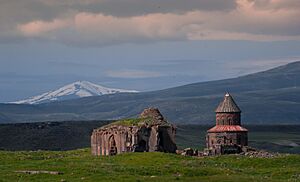
Church of the Holy Apostles and Church of Saint Gregory of Abughamrentz, Ani
|
|
| Location | Ocaklı (nearest settlement), Kars Province, Turkey |
|---|---|
| Region | Armenian highlands |
| Coordinates | 40°30′27″N 43°34′22″E / 40.50750°N 43.57278°E |
| Type | Settlement |
| History | |
| Founded | 5th century (first mentioned) |
| Abandoned | 17th century |
| Periods | Middle Ages |
| Cultures | Armenian (predominantly) |
| Site notes | |
| Ownership | Kingdom of Armenia (Middle Ages) |
| Official name | Archaeological Site of Ani |
| Type | Cultural |
| Criteria | ii, iii, iv |
| Designated | 2016 (40th session) |
| Reference no. | 1518 |
| Region | Europe and North America |
| historical population of over 100,000 | |
Ani is a fascinating ruined medieval city. It is located in Turkey's Kars Province, very close to the border with Armenia.
From 961 to 1045, Ani was the capital of the Bagratid Armenian kingdom. This kingdom covered a large part of what is now Armenia and eastern Turkey. Ani was so grand that people called it the "City of 1,001 Churches." While that number was an exaggeration, archaeologists have found many churches and chapels.
Ani was an important stop on various trade routes. Its many religious buildings, palaces, and strong walls made it special. The Cathedral of Ani is one of its most famous buildings. Some experts believe its design influenced great cathedrals in Europe. At its peak, Ani was a very large city, possibly with over 100,000 people.
In 1236, the Mongols attacked and damaged Ani. The city never fully recovered after a big earthquake in 1319. Also, trade routes changed, which hurt Ani's economy. By the 17th century, the city was abandoned. Today, Ani is a significant symbol of Armenian history and culture. In 2016, it became a UNESCO World Heritage Site. This helps protect the site and promotes cultural understanding.
Contents
- What's in a Name?
- Where is Ani Located?
- A Look at Ani's History
- Ani Today
- UNESCO World Heritage Site
- Important Buildings at Ani
- The Cathedral
- The Church of St Gregory of Tigran Honents
- The Church of the Holy Redeemer
- The Church of St Gregory of the Abughamrents
- King Gagik's Church of St Gregory
- The Church of the Holy Apostles
- Surp Stephanos Church
- The Mosque of Manuchihr
- The Citadel
- The City Walls
- Other Interesting Spots
- Cave Village
- Gallery
- Ani in Culture
- See also
What's in a Name?
The city of Ani got its name from an old Armenian fortress-city. This fortress was called Ani-Kamakh. It was a religious center before Christianity became widespread. Historians are not sure why Ani was also known as Khnamk for a time. Some think the name Ani might come from an ancient Iranian goddess named Anāhita.
Where is Ani Located?
Ani is built on a triangular piece of land. This spot is naturally protected and looks very dramatic. On one side, it has the deep valley of the Akhurian River. On the other side is the Bostanlar valley. The Akhurian River forms part of the border between Turkey and Armenia. The city sits high up, about 1,340 meters (4,400 feet) above sea level.
Ani is in the Turkish province of Kars. Kars is known for its livestock and cheese. It is also an important military area because it is near the Armenian border. Ani itself is only about 400 meters (1,300 feet) from this border.
A Look at Ani's History
Early Beginnings
Armenian writers first mentioned Ani in the 5th century. They described it as a strong fortress on a hilltop. It belonged to the Armenian Kamsarakan dynasty at that time.
Capital of the Bagratuni Kingdom
By the early 9th century, Ani became part of the Bagratuni lands. The Bagratunis were a powerful Armenian dynasty. They gained independence from Arab rule in the late 9th century. King Ashot I helped them achieve this freedom.
The Bagratuni dynasty created many famous works of art and architecture. The Cathedral of Ani is one example. In 961, King Ashot III moved the capital to Ani. The city grew very quickly under King Smbat II (977–989). By 992, the head of the Armenian Church also moved to Ani.
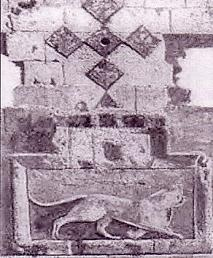
In the 10th century, Ani's population was between 50,000 and 100,000 people. By the early 11th century, it was over 100,000. Ani became known as the "city of forty gates" and the "city of a thousand and one churches." It was also where Bagratuni kings were buried.
Ani reached its greatest power during the reign of King Gagik I (989–1020). After he died, his sons argued over who would rule. One son, Hovhannes-Smbat, controlled Ani. He feared the Byzantine Empire might attack. So, he made the Byzantine Emperor Basil II his heir.
When Hovhannes-Smbat died in 1041, the Byzantine Emperor claimed Ani. The new king of Ani, Gagik II, fought back. Several Byzantine armies tried to capture Ani but failed. However, in 1046, Ani surrendered to the Byzantines. This happened after Gagik was tricked into going to Constantinople and held there. A Byzantine governor then took charge of the city.
A Center for Culture and Trade
Ani was already on important trade routes. But its size, power, and wealth made it a major trading hub. It traded with the Byzantine Empire, the Persian Empire, and Arab lands. It also traded with smaller nations in southern Russia and Central Asia.
Slow Decline and Being Left Behind
In 1064, a large Seljuk army led by Alp Arslan attacked Ani. After a 25-day siege, they captured the city.
In 1072, the Seljuks sold Ani to the Shaddadids. This was a Muslim Kurdish family. The Shaddadids usually treated Ani's Armenian Christian people well. They even married into the Bagratid royal family. But if their rule became too strict, the people would ask the Christian Kingdom of Georgia for help. The Georgians captured Ani five times between 1124 and 1209.
Zakarids Take Over (1199-1239)
In 1199, Georgia's Queen Tamar captured Ani. In 1201, she gave control of the city to her generals, Zakare and Ivane. Zakare's family, the Zakarids, saw themselves as the Bagratids' successors. Ani quickly became prosperous again. Its defenses were made stronger, and many new churches were built.
In 1217 and 1220, the city was attacked by the Seljuk Sultanate of Rum. Their forces damaged and looted the city. However, they did not stay and occupy it.
Mongol Capture (1239)
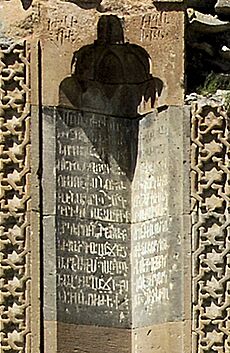
The Mongols tried to capture Ani in 1226 but failed. However, in 1236, they succeeded. They captured and looted the city, and many people were killed. After this, the Armenians and Georgians made peace with the Mongols. They agreed to pay tribute and provide soldiers for the Mongol army.
By the end of the 14th century, different Turkish families ruled Ani. These included the Jalayrids and the Kara Koyunlu (Black Sheep clan). The Kara Koyunlu even made Ani their capital. A big earthquake in 1319 caused more damage to the city. Tamerlane captured Ani in the 1380s.
After Tamerlane died, the Kara Koyunlu got control back. But they moved their capital to Yerevan. In 1441, the head of the Armenian Church also moved from Ani. The Persian Safavids then ruled Ani until 1579. At that point, it became part of the Turkish Ottoman Empire. A small town remained inside Ani's walls until the mid-17th century. But by 1735, the site was completely abandoned.
Modern Discoveries
In the early 1800s, European travelers rediscovered Ani. They wrote about its grand public buildings and strong double walls. In 1878, Ani became part of the Russian Empire.
The first archaeological digs at Ani began in 1892. They were led by the Georgian archaeologist Nicholas Marr. Marr's excavations continued from 1904 to 1917. Large parts of the city were carefully dug up. Many buildings were found and measured. A museum was even set up to hold the thousands of items found. Marr's team also made emergency repairs to buildings that were about to fall apart.
In 1918, during World War I, Turkish armies moved into the area. Attempts were made to move the artifacts from Ani's museum to safety. About 6,000 items were saved by archaeologist Ashkharbek Kalantar. These items are now part of the State Museum of Armenian History in Yerevan. Sadly, everything left behind was later lost or destroyed.
After World War I, Ani briefly returned to Armenian control. But in 1920, Turkey recaptured Ani. In 1921, the Treaty of Kars officially made Ani part of the Republic of Turkey. Some destruction happened at the site, including parts of Marr's excavations.
During the Cold War, Ani was on the border between Turkey and the Soviet Union. There were talks in 1968 about Ani being given to Soviet Armenia. But nothing came from these discussions.
Ani Today
Today, it is much easier to visit Ani. You no longer need special permission from the Turkish government. You can simply go to Ani and buy a ticket. Many people hire a taxi or minibus from Kars to get there. It's a good idea to plan at least half a day to explore the site.
From the Armenian side of the border, you can see Ani from a distance. However, the view is often not very clear.
Ani has faced many challenges over time. These include neglect, earthquakes, and even damage from nearby quarries. The Landmarks Foundation says that this ancient city needs protection, no matter who controls it. Earthquakes in 1319, 1832, and 1988 have all caused damage.
The Global Heritage Fund listed Ani as one of the world's most endangered sites in 2010. They pointed to poor management and looting as main problems. The World Monuments Fund (WMF) also put Ani on its list of endangered sites in 1996, 1998, and 2000. In 2011, WMF started working with the Turkish Ministry of Culture to help preserve the cathedral and the Church of the Holy Redeemer.
UNESCO World Heritage Site
In 2016, the archaeological site of Ani was added to the UNESCO World Heritage List. This means it is recognized as very important to the world. Being on this list helps protect the site and brings in experts and funding.
Ani earned this status for several reasons:
- A Meeting Place of Cultures: Ani was a place where Armenian, Georgian, and different Islamic cultures met. This mix of cultures influenced the buildings' designs and decorations. Its location on the Silk Road brought many visitors and new ideas. This led to a unique architectural style found only in this region.
- Amazing Armenian Architecture: Ani shows how Armenian architecture, art, and city planning developed. It is a great example of the "Ani school" of Armenian religious architecture. The beautiful stone work and designs were very advanced for their time. This is a source of pride for the Armenian people.
- A History of Building Styles: Ani offers a wide view of medieval architecture. You can see almost all the building styles that appeared in the region from the 7th to the 13th centuries. This includes military, religious, and everyday buildings. UNESCO also calls Ani a "rare settlement" because it has many different styles of Armenian churches. These styles developed between the 4th and 8th centuries.
Ani is now a 1st-degree archaeological conservation site by UNESCO. This means it has a high level of protection. The Turkish Ministry of Culture and Tourism is mainly in charge of its preservation.
Important Buildings at Ani
All the buildings at Ani are made from a local volcanic stone called tufa. This stone is easy to carve and comes in many bright colors. Sadly, due to attacks and natural disasters, all the buildings have been damaged. Some have even been completely destroyed. Here are some of the most important ones that still stand:
The Cathedral
This church is also known as Surp Asdvadzadzin, or the Church of the Holy Mother of God. Its construction began in 989 under King Smbat II. It was finished in 1001 (or 1010). The famous architect Trdat designed it. The cathedral was a domed basilica, but its dome fell in 1319. Inside, it has features like pointed arches that look like Gothic architecture. This is interesting because the Ani cathedral was built centuries before Gothic style became popular in Europe.
The Church of St Gregory of Tigran Honents
This church was finished in 1215. It is the best-preserved building at Ani. A rich Armenian merchant named Tigran Honents had it built. The outside of the church is beautifully decorated. It has detailed stone carvings of real and imaginary animals. Inside, there are unique frescoes (wall paintings). These paintings show the life of Saint Gregory the Illuminator and the life of Christ. These large fresco cycles are rare in Armenian churches. It is thought that Georgian artists painted them.
The Church of the Holy Redeemer
This church was completed shortly after 1035. It had a very special design: 19 sides on the outside and 8 curved sections inside. A huge dome sat on a tall base. Prince Ablgharib Pahlavid built it to hold a piece of the True Cross. Most of the church was intact until 1955. Then, the entire eastern half collapsed during a storm.
The Church of St Gregory of the Abughamrents
This small church likely dates from the late 10th century. It was built as a private chapel for the Pahlavuni family. The church has a central design with a dome. Inside, it has six curved sections.
King Gagik's Church of St Gregory
This church was built between 1001 and 1005. It was meant to be a copy of the famous Zvartnots Cathedral in Vagharshapat. Archaeologist Nikolai Marr found its foundations in 1905 and 1906. Before that, it was just a large mound of earth. The architect Trdat designed this church. It is known that the church collapsed soon after it was built. Houses were later built on top of its ruins.
The Church of the Holy Apostles
The exact date this church was built is unknown. But the oldest writing on its walls is from 1031. The Pahlavuni family founded it. It was used by the archbishops of Ani. Only parts of the church remain. However, a narthex (an entrance hall) with amazing stonework is still partly standing. It dates from the early 13th century.
Surp Stephanos Church
There is no writing that tells us when this church was built. But a Georgian text from 1218 mentions it. The church was called "Georgian." At that time, "Georgian" could mean someone who followed the Chalcedonian Christian faith. Most of the people who attended this church were Armenians.
The Mosque of Manuchihr
This mosque is named after Manuchihr. He was the first ruler of the Shaddadid family who controlled Ani after 1072. The oldest part of the mosque is its minaret (tower for calling to prayer). It has the Arabic word Bismillah ("In the name of God") written on it. The prayer hall was built later, in the 12th or 13th century. In 1906, the mosque was partly repaired to hold a museum. Restoration of the mosque began in June 2020.
The Citadel
At the southern end of Ani is a flat-topped hill. It was once called Midjnaberd, meaning the Inner Fortress. It has its own defensive walls from the 7th century. Nicholas Marr excavated this hill in 1908 and 1909. He found the ruins of the palace of the Bagratid kings. Inside the citadel, you can also see the ruins of three churches and other buildings. One of these, the "church of the palace," is the oldest church in Ani. It dates from the 6th or 7th century.
The City Walls
Ani was protected by a line of walls that went around the whole city. The strongest defenses were on the northern side. This was the only part not protected by rivers or valleys. Here, the city had a double line of walls. The inner wall was much taller and had many large, round towers close together. Old writers said King Smbat (977–989) built these walls. Later rulers made them even higher and thicker. They also added more towers. The northern walls had three gates: the Lion Gate, the Kars Gate, and the Dvin Gate.
Other Interesting Spots
There are many other smaller monuments at Ani. These include a convent called the Virgins' chapel. There's also a church used by Chalcedonian Armenians. You can see the remains of a single-arched bridge over the Arpa river. There are also ruins of oil-presses and several bath houses. You can find parts of another mosque, a palace from the 13th century, and foundations of other palaces and homes. Recently, parts of streets lined with shops have also been found.
Cave Village
Right outside Ani's city walls, there was a settlement carved into the cliffs. This might have been where people lived when Ani became too crowded. Today, goats and sheep use these cool caves. One special part of this area is a cave church with frescoes on its walls and ceiling.
Gallery
- '''Cathedral of Ani'''
- '''The church of the Holy Redeemer'''
- '''The church of St Gregory of the Abughamrents'''
- '''The church of St Gregory of Tigran Honents'''
- '''Monastery of the Hripsimian Virgins'''
Panorama
Ani in Culture
The name Ani is one of the most popular girl's names in Armenia.
Many songs and poems have been written about Ani's past glory. "Tesnem Anin u nor mernem" (Let me see Ani before I die) is a famous poem by Hovhannes Shiraz. It was even turned into a song. The musician Ara Gevorgyan named his 1999 album of folk songs Ani.
A Turkish perfume brand created a scent called Ani in 2019. It was dedicated to the city and has been well-received. The perfume's artwork features one of Ani's churches.
See also
 In Spanish: Ani para niños
In Spanish: Ani para niños



